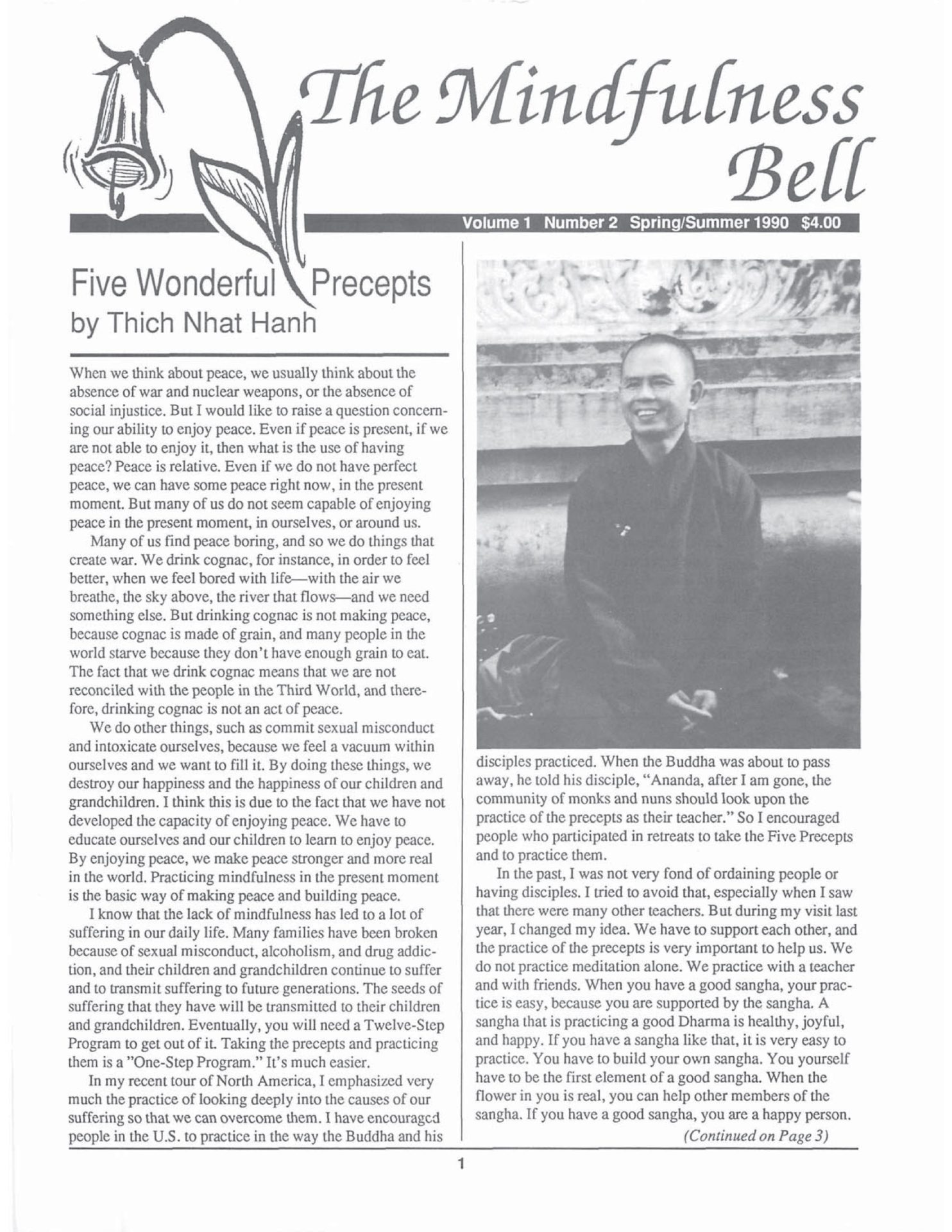Note: The original article was prepared using a typeface designed for Vietnamese diacritical marks.
Ed. Note: If you received the Five Precepts from Thich Nhat Hanh, your Dharma name, if you asked to receive one, begins with the word Tam, “Mind” or “Heart,” and you belong to the ninth generation of the Lieu Quan School of Zen, and the forty-third generation of the Lin Chi (Japanese: Rinzai) school of Zen.
Note: The original article was prepared using a typeface designed for Vietnamese diacritical marks.
Ed. Note: If you received the Five Precepts from Thich Nhat Hanh, your Dharma name, if you asked to receive one, begins with the word Tam, “Mind” or “Heart,” and you belong to the ninth generation of the Lieu Quan School of Zen, and the forty-third generation of the Lin Chi (Japanese: Rinzai) school of Zen. Note that in the verse in the last paragraph of this essay, the ninth character is Tam (Mind or Heart).
Master Lieu Quan was born in the village of Bac Ma in the Phu Yen province, in Vietnam, in 1670. He lost his mother at the age of six. His father used to bring him to the Hoi Ton Temple, where he met the abbot, Te Vien. At the age of ten, he was accepted in the temple as a novice. He studied with Te Vien for nine years.
When Master Te Vien passed away, Lieu Quan went to the far away province of Thuan Hoa (now Hue) to study with the Master Giac Phong at the Thien Tho Temple, now called Bao Quoc. One year later when he received news that his father was sick, he asked permission to go back to his village where he worked as a logger to support his father. Four years later, his father died and he went back to study and practice at Thien Tho Temple. He was ordained as a bhiksu in 1697 at the age of twenty-seven.
In 1702, he met Master Tu Dung and began to study with him at the An Tong Temple in Thua Thien. For five years, he was given the Cong an: “All dharmas return to the one. Where will the one return to?”
In 1708, he went back to his teacher, Master Tu Dung told him:
Alone let yourself go down to the abyss. The only way to be reborn is to die. Who could blame you after that?
Lieu Quan clapped his hands and laughed. Tu Dung said: “Not ripe yet.” Lieu Quan tried once more: “The hammer is iron itself.” Tu Dong shook his head. Lieu Quan went back to his cell. The next day, Tu Dung was passing by Lieu Quan’s cell and called out to him: “Our conversation of yesterday is not finished yet. Tell me again!”
Lieu Quan replied, “If I had known that the lamp is fire itself, then the meal could have been ready a long time ago.” Master Tu was delighted by this reply.
Lieu Quan was thirty-eight when he receiving this transmission and set up the Thien Tong Meditation Center. He allowed the Vien Thong Center to be built by his students at the foot of the Ngu Binh Mountain. Lord Nguyen Phuc Khoat used to come to this center to practice. In the years 1733-1735, four national ceremonies of ordination were organized in the Thua Thien province over which Master Lieu Quan presided. The number of his disciples were as many as 4000. In 1740, he presided over an ordination at the Long Hoa Center and in 1742, at another one organized at the Vien Thong Center. Practice centers of the Lieu Quan School were set up everywhere in the country. The Phu Yen province is one of the strongholds of the school, along with the Hoi Tong, Co Lam, and Bo Tinh temples.
On the morning of the twenty-first day of the eleventh month of the lunar calendar, 1742, Master Lieu Quan asked his attendant to bring him a pen and a piece of paper. He wrote this gatha:
During the seventy or more years I have been in this world, Form and Emptiness have always been the same. Today, all vows fulfilled, I am going back to my home. Do not tire yourselves out asking questions Concerning schools and patriarchs.
After finishing the gatha, the Master sat quietly drinking his tea. Monks living at the center came to see him. Some of the monks cried. Lieu Quan said, “Please do not cry! Even Buddhas have to enter nirvana. My coming and going is clear. There is nothing to be sorrowful about.” The monks stopped crying. He asked, “Has the mui hour (from 1-3 p.m.) come? People said, “Yes.” Lieu Quan said:
The great Way of Reality is the pure ocean of the true nature. The source of Mind has penetrated everywhere. From the roots of virtue springs the tradition of compassion. Vinaya, Samadhi, and prajna— the nature and function of all three is one. The fruit of transcendent wisdom can be realized by being wonderfully together. Maintain and transmit the wonderful principle in order to make known the true teaching! For the realization of true emptiness to be possible, wisdom and action have to arise together.
That (Reality) te (Domain) dai (Great) dao (Way) Tanh (Nature) hai (Ocean) thanh (Clear) trung (Calm) Tam (Mind) nguyen (Source) quang (Broad) nhuan (Penetration) Duc (Virtue) bon (Roots) Tu (Loving Kindness) phong (Tradition) Gioi (Precepts) Dinh (Concentration) phuoc (Merits) hue (Wisdom) The (Body, Self-nature) dung (Function) vien (Complete) thong (Communication) Vinh (Eternity) sieu (Transcending) tri (Wisdom) qua (Fruit) Mat (Mystically) khe (Corresponding) thanh (Realization) cong (Work) Truyen (Transmission) tri (Maintaining, Practicing) dieu (Wonderful) ly (Truth) Dien (Expounding) xuong (Speaking) chanh (True, Legitimate) tong (School) Hanh (Action) giai (Understanding) tuong (Together) ung (Corresponding) Dat (Attaining) ngo (Awakening) chan (True) khong (Emptiness)

